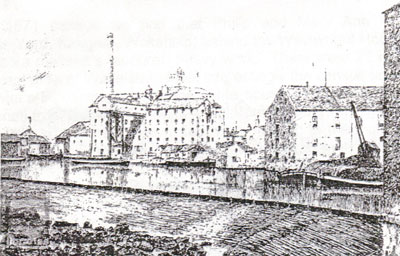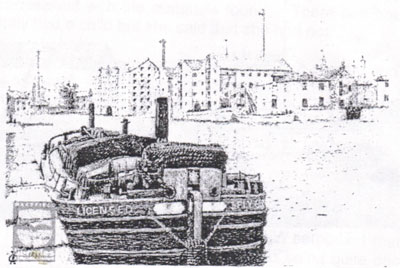Walsham to Wakefield: A move up north

I am a direct descendant of Robert Hawys, mentioned in the 14th century Walsham Manor court rolls. Today, however, I pride myself in being a Yorkshireman. Yorkshire, of course, is the best county, an opinion that may be questioned in Suffolk! I owe my white rose status to my great grandfather Philip Hawes who moved to Wakefield with his wife Mary Ann in the 1860s.
Philip was the son of William Hawes, an agricultural labourer born in Walsham, and Mary Moss from the nearby village of Finningham, where they had married in 1824. After their first child was born in 1825 the couple had moved to nearby Gislingham, raising a large family. William was to spend his life working on farms at that village, where he died aged 74 in 1871. His memorial can still be seen in the churchyard. Philip, their eighth child, born in 1842, was set to follow his father working on the land at Gislingham, but his life turned out very differenely.
The early years of Victoria’s reign were known as “the hungry forties”, and this was particularly true for agricultural workers such as the Hawes family. The so-called “Agricultural Revolution”, a direct result of the Industrial Revolution, was gaining momentum. The availability of agricultural work was reduced because of mechanisation and improved farming methods, and many men were out of a job. In former times they could apply for relief in their own parish, but a parliamentary Act of 1834 radically reformed those earlier Poor Laws. All but the largest parishes were grouped into “Unions” big enough to provide an efficient Workhouse. Local temporary relief was to cease and the only help available was centralized at the Union Workhouse, often many miles away. These workhouses, as depicted by Dickens in “Oliver Twist”, were to be made as unpleasant as possible, so that only the direst need would drive men and women to seek relief. The separation of husband, wife and children, coarse diet, severe discipline and hard work were the features long to be hated and dreaded by the rural poor. The often parodied but tragic poem “Christmas Day in the Workhouse” was written as late as 1879.

Under a Pauper Migration Scheme organized by the Government 1836-7 huge numbers of the agricultural labouring poor were encouraged to move north, away from this unhappiness. Although the scheme was short-lived, it succeeded in employing rural workhouses and provided an example to northern industrial entrepreneurs to liaise with rural clergy, landowners and workhouse guardians to encourage further migration over many decades.
Philip Hawes, mentioned above, began his working life as an agricultural labourer. Aged 22, he married Mary Ann Sterry at Gislingham church on 30th April 1864. Mary Ann, another labourer’s daughter, had been in service with the Browne family at 43, Long Green, Wortham, then a substantial Suffolk village. Philip and Mary Ann’s first child Eliza had been born on 24th March 1864. She was christened at Gislingham on 1st May, the day after Philip and Mary Ann’s hasty wedding. At some unspecified time in 1865 this young family decided to try their fortunes in Wakefield.
From the early days of the century poorer people travelled north by river and canal. The journey took at least three weeks, and usually the traffic was organised by Pickfords. The company had entered water transport in the 1780s and by 1838 they had 116 boats and 398 draught horses. With large warehouses in London, they were able to transport goods all over the country. Wakefield, an ancient city on the River Calder, had long been a centre for the cloth trade. With the Industrial Revolution it had became important in the Yorkshire coal field. Many other industries grew in this boom town, including the processing of coal.
From the 1871 census we find that Philip and Mary Ann lived at 53 Wainwrights Yard, Kirkgate, Wakefield, behind the Wainwright Hotel. Philip is desribed as a maltster’s labourer, heavy work. There were 21 malt houses in the Kirkgate area of Wakefield. Most interestingly the census tells us of two other maltster’s labourers living in the same house as Philip and Mary Ann: Willian Genell from Felsham in Suffolk and Walter Sterry (surely a relative of Mary Ann) from Rickinghall. Also listed as connected to the malting industry in the area are: (in alphabetical order) Samuel Aldridge “from Suffolk”; Walter Calton from Wattisfield: Ezra Everson from Brockford: Jane Everson, presumably his wife, born in Rickinghall; Henry Everson “from Suffolk”; Henry Genell from Felsham, presumably related to William Genell of the same village; John Huggins from Botesdale. Also listed in the 1871 census are four Suffolk people connected with the malt trade who had been resident in Kirkgate for at least ten years, for they are listed in the 1861 census. They were Joseph Rumsby, his wife Maria, and her two brothers James and William Peace, all from Rickinghall. It is highly likely that this network of people, with Rickinghall as a recurrent common factor, would have encouraged Philip and Mary Ann to try their fortune in Wakefield.
David Hawes
Acknowlegements
- Information and assistance supplied by John Hawes, Rob Barber and Katie Vaughan
- Edited by Brian Turner
- More information on the Hawes family is kept in Walsham Family Research Archive.
- Contact: James Turner Tel: 01359 259411 email: jamesturner3180@btinternet.com
What The Papers Said
Bury Free Press 12th February 1859
A Suspicious Case in Walsham
‘Considerable sensation has been caused in the village by the discovery of the dead body of an infant in a pond near Mills Lane.’
(This lane, still a footpath, ran from Clay Street, near The Pound, crossing the fields and then the road to join Hartshall Lane.)
‘An inquest was held in the Boar Inn before a coroner. Witness Mr. Plummer deposed that he saw a bundle lying in a pond along Mills Lane and called a man named Denny to help. Getting the bundle out they found the body of a child and a stone wrapped in two pieces of linen.
Thomas Denny said that Mr. Plummer, who was ploughing a field, asked him for help. They broke the ice and retrieved the bundle that was wrapped in an apron. Inspector Durrant said that he saw the body at Mr. Fred Plummer’s house and saw that the linen had the letters “H.P,” sewn in red cotton. He had searched the house of Hannah Pallant in Walsham but could not find anything to correspond with the materials found. There had been talk that she had recently had a child but she said that she had not.
Hannah Pallant had worked at Westhorpe Lodge as a servant and two fellow servants gave witness. “She left us last September because she was ill and although it was not noticeable she had said that she was in a family way. I knew that she had taken some steel drops because I saw the words on a bottle.” “I knew her and often helped her to wash her linen and know that her chemises were marked H.P.”
Mr. Walton Kent, surgeon of Walsham, deposed that a Post Mortem examination on the body found it to be a fine male child, fully grown and developed. There were no marks of violence and he opined that the body had been in the pond at least a fortnight, the brain being quite decomposed. The navel cord was torn and he was of the opinion that death had taken place immediately after labour thus before entering the water.
Mary, wife of John Pallant and mother of Hannah, stated that her daughter was now at home ill in bed as she had been for a long time. To the best of her knowledge she had not had a child.
The coroner summed up the case and the jury returned the following verdict. “It is the opinion of this jury that the child had breathed and then died in consequence of a protracted labour.”‘

